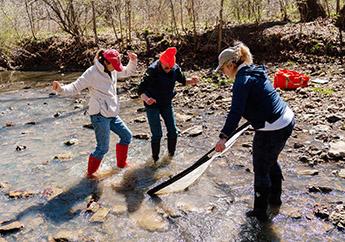
The Volunteer Water Quality Monitoring (VWQM) Program is an opportunity for citizens to learn about water quality and get involved in one of Missouri Stream Team's most popular activities. Program goals include:
- Informing and educating citizens about the conditions of our streams
- Establishing a monitoring network
- Generating water quality data
- Enabling citizens
- Halting degradation of Missouri streams
VWQM engages people of all ages in the work of improving the health of Missouri’s streams. VWQM teaches citizens about watershed health, water quality and how to monitor a stream and collect useful data. Volunteer data can be used to inform and educate Missouri citizens, establish baseline data on rarely sampled streams, locate emerging water quality problems and identify long term trends in stream conditions. Highly trained volunteers collect data that may supplement agency-collected data. For more information regarding the Volunteer Water Quality Monitoring Program and data, please email streamteam@dnr.mo.gov.
*The Missouri Stream Team Program is a partnership between the Missouri Department of Natural Resources, Missouri Department of Conservation, Conservation Federation of Missouri and the citizens of Missouri. To learn more about the Missouri Stream Team program and the other activities offered for citizen engagement, visit the Missouri Stream Team website.

